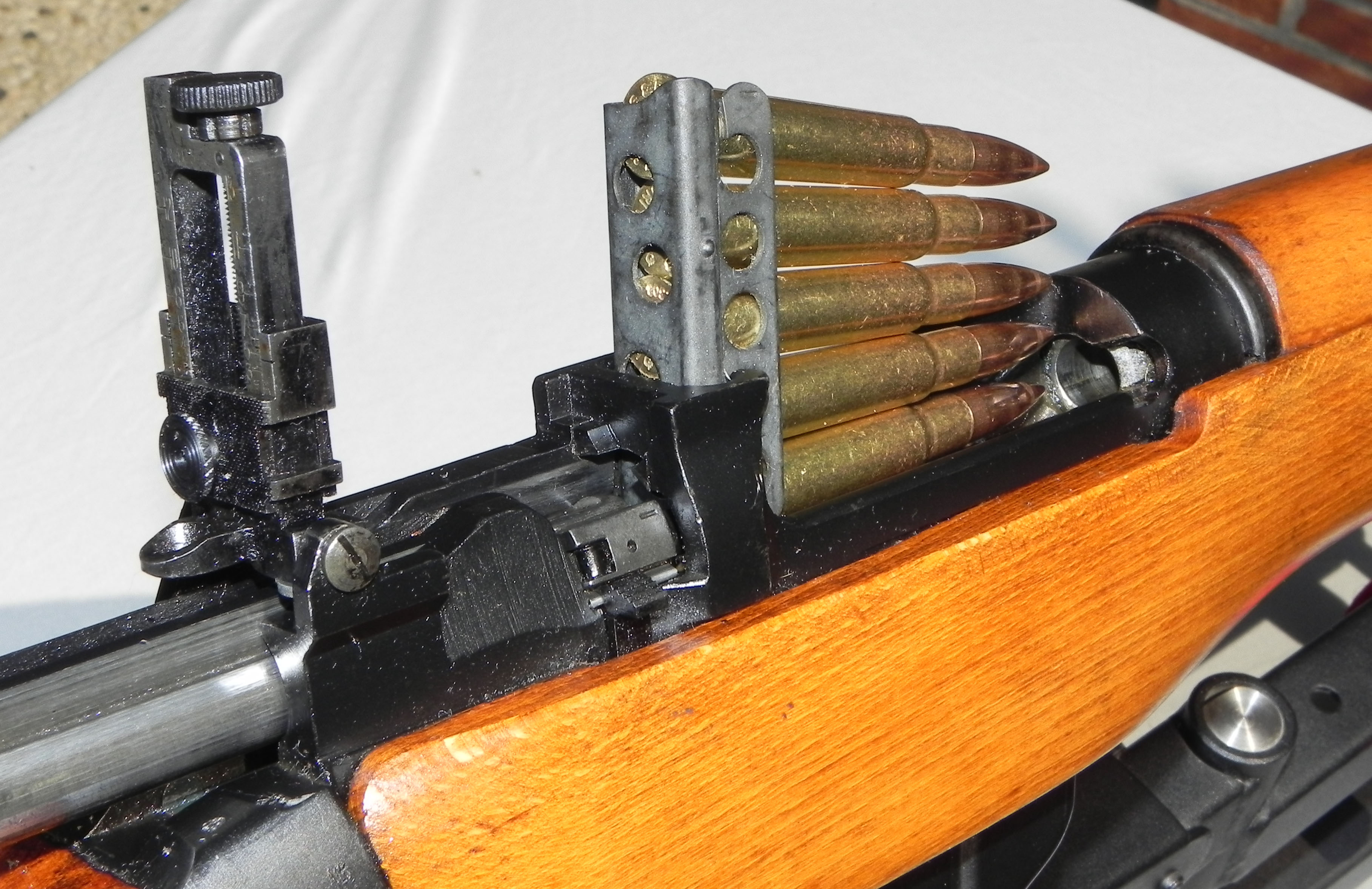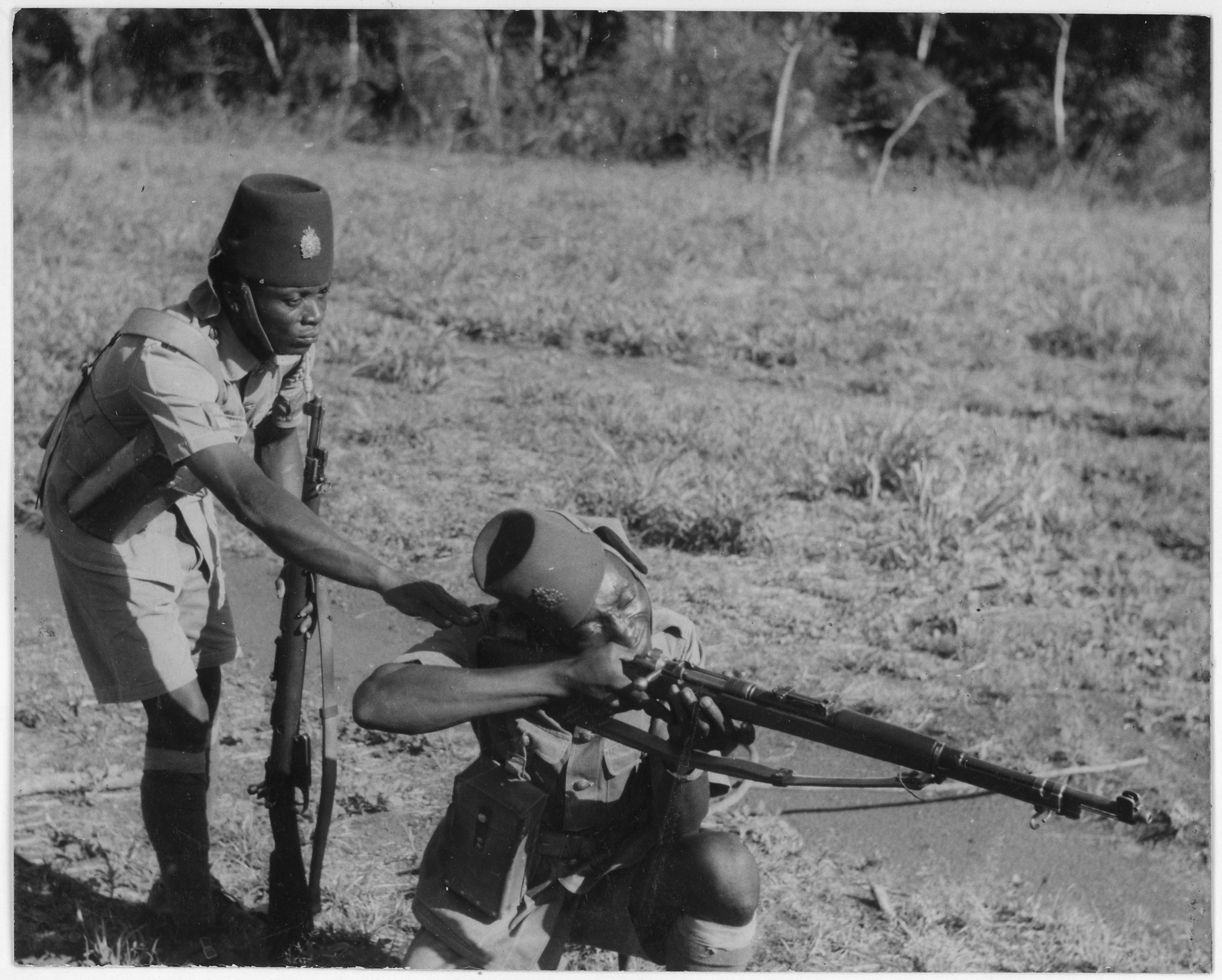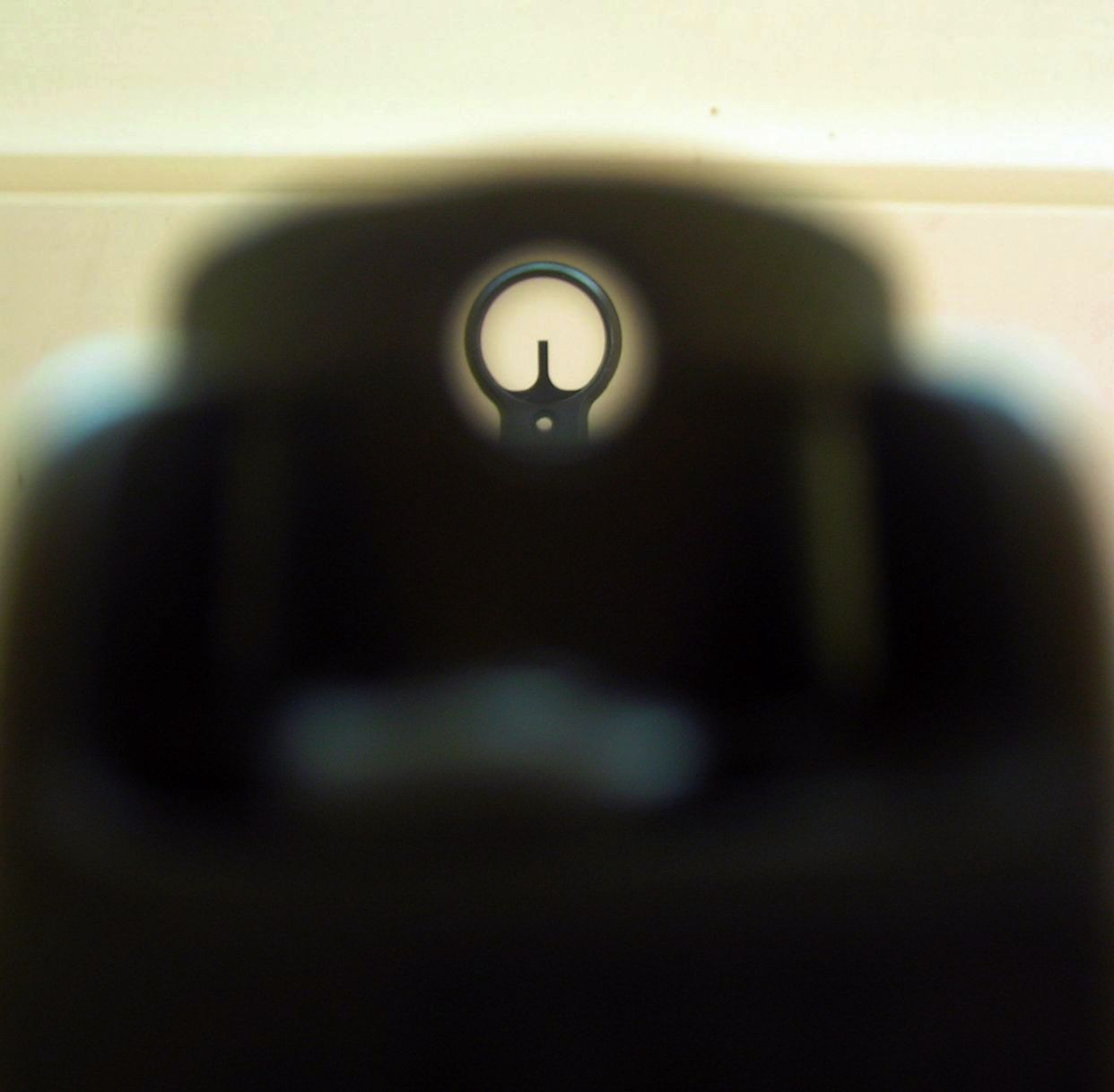|
Mauser Model 1893
The Mauser Model 1893 is a bolt-action rifle commonly referred to as the Spanish Mauser, though the model was adopted by other countries in other calibers, most notably the Ottoman Empire. The M1893 was based on the experimental M1892 rifle, which Paul Mauser developed for the Spanish Army as part of a program to correct deficiencies in the earlier Mauser Model 1889, 1889, 1890, and 1891 series of Mauser rifles. The M1893 introduced a short staggered-column box magazine that fit flush with the bottom of the stock; the magazine held five Smokeless powder, smokeless 7×57mm Mauser rounds, which could be reloaded quickly by pushing a stripper clip from the top of the open bolt. The M1893 was developed into several variants, including a shortened carbine adopted by the Spanish as the M1895, and as the M1913 and M1916 short rifles. All versions of the rifle saw extensive service in the Spanish Army, beginning in the Spanish–American War in 1898, the Rif War of 1920–1927, and the S ... [...More Info...] [...Related Items...] OR: [Wikipedia] [Google] [Baidu] |
Bolt-action
Bolt action is a type of manual Action (firearms), firearm action that is operated by ''directly'' manipulating the bolt (firearms), turn-bolt via a cocking handle, bolt handle, most commonly placed on the right-hand side of the firearm (as most users are right-handed). The majority of bolt-action firearms are rifles, but there are also some variants of shotguns and handguns that are bolt-action. Bolt action firearms are generally repeating firearms, but many single-shot designs are available particularly in shooting sports where single-shot firearms are mandated, such as most Olympic and International Shooting Sport Federation, ISSF rifle disciplines. From the late 19th century all the way through both World Wars, bolt action rifles were the standard infantry service rifle, service weapons for most of the world's military forces, with the exception of the United States Armed Forces, who used the M1 Garand Semi-automatic rifle. In modern military and law enforcement after ... [...More Info...] [...Related Items...] OR: [Wikipedia] [Google] [Baidu] |
Ludwig Loewe & Company
''Deutsche Waffen- und Munitionsfabriken Aktiengesellschaft'' (German Weapons and Munitions public limited company), known as DWM, was an arms company in Imperial Germany created in 1896 when ''Ludwig Loewe & Company'' united its weapons and ammunition production facilities within one company. In 1896 Loewe founded Deutsche Waffen- und Munitionsfabriken with a munitions plant in Karlsruhe (Baden), formerly Deutsche Metallpatronenfabrik Lorenz, and the weapons plant in Berlin. Shares that Loewe had in other gun- and ammunition plants were transferred to DWM. This included Waffenfabrik Mauser, Fabrique Nationale d'Armes de Guerre (FN) in Belgium and Waffen- und Munitionsfabrik A.G. in Budapest. The DWM was orchestrated by (1848–1910), as his brother Ludwig had died in 1886. Karl Maybach (who was part of the Maybach company) was employed by the Loewe company in 1901. Firearms DWM introduced the Pistol Parabellum ('Luger Pistol') in the early 1900s. It was worked on by Georg Lu ... [...More Info...] [...Related Items...] OR: [Wikipedia] [Google] [Baidu] |
Stripper Clip
A stripper clip (also known as a charger or charger clip, especially in Commonwealth English military vocabulary) is a speedloader that holds several cartridges (usually between 5 and 10) together in a single unit for easier and faster loading of a firearm magazine. Stripper clips were originally employed in infantry bolt-action rifles, such as the Russian Mosin–Nagant, the British Lee–Enfield, and the German Mauser Model 1889, Gewehr 98, and its variant the Karabiner 98k, the related American M1903 Springfield and M1917 Enfield, Swiss K31, and many others. Stripper clips were also employed in newer, semi-automatic rifles with internal box magazines, such as the Soviet SKS and the Egyptian Hakim Rifle. Semi and full automatic firearms using both stripper feed inserts and detatchable box magazines are the Canadian (FNC1A1) version of the L1A1 self-loading rifle, the US OA-96 carbine and T48 rifles and the Chinese Type 63 and Type 81 assault rifles. Current ... [...More Info...] [...Related Items...] OR: [Wikipedia] [Google] [Baidu] |
Smokeless Powder
Finnish smokeless powder Smokeless powder is a type of propellant used in firearms and artillery that produces less smoke and less fouling when fired compared to black powder. Because of their similar use, both the original black powder formulation and the smokeless propellant which replaced it are commonly described as gunpowder. The combustion products of smokeless powder are mainly gaseous, compared to around 55% solid products (mostly potassium carbonate, potassium sulfate, and potassium sulfide) for black powder. In addition, smokeless powder does not leave the thick, heavy fouling of hygroscopic material associated with black powder that causes rusting of the barrel. Despite its name, smokeless powder is not completely free of smoke; while there may be little noticeable smoke from small-arms ammunition, smoke from artillery fire can be substantial. Invented in 1884 by Paul Vieille, the most common formulations are based on nitrocellulose, but the term was also used to ... [...More Info...] [...Related Items...] OR: [Wikipedia] [Google] [Baidu] |
Mauser Model 1889
The Mauser Model 1889 is a bolt-action rifle of Belgian origin. It became known as the 1889 Belgian Mauser, 1890 Turkish Mauser, and 1891 Argentine Mauser. History After the Mauser brothers finished work on the Model 71/84 in 1880, the design team set out to create a small caliber repeater that used smokeless powder. Because of setbacks brought on by Wilhelm Mauser's death, they failed to have the design completed by 1882, so the German Rifle Test Commission () was formed. The commission preferred to create their own design. Paul Mauser, who was not aware of the commission's work until 1888, managed to sell an improved version of his M1871/84 rifles as M1887 to the Ottoman Empire. Meanwhile, in the mid-1880s, Belgium wanted to adopt a magazine rifle to replace the Albini-Braendlin, Terssen and Comblain 11-mm single-shots. In 1886, Manufacture d’Armes de L’État started trials of several mostly foreign designs (including Kropatchek and Jarmann) of which the M1885 Reming ... [...More Info...] [...Related Items...] OR: [Wikipedia] [Google] [Baidu] |
Spanish Army
The Spanish Army () is the terrestrial army of the Spanish Armed Forces responsible for land-based military operations. It is one of the oldest Standing army, active armies – dating back to the late 15th century. The Spanish Army has existed continuously since the reign of Ferdinand II of Aragon, King Ferdinand and Isabella I of Castile, Queen Isabella (late 15th century). The oldest and largest of the three services, its mission was the defence of Peninsular Spain, the Balearic Islands, the Canary Islands, Melilla, Ceuta and the Spanish islands and rocks off the northern coast of Africa. History During the 16th century, Habsburg Spain saw steady growth in its military power. The Italian Wars (1494–1559) resulted in an ultimate Spanish victory and hegemony in northern Italy by expelling the French. During the war, the Spanish Army transformed its organization and tactics, evolving from a primarily Pike (weapon), pike and halberd wielding force into the first pike and shot ... [...More Info...] [...Related Items...] OR: [Wikipedia] [Google] [Baidu] |
Ottoman Empire
The Ottoman Empire (), also called the Turkish Empire, was an empire, imperial realm that controlled much of Southeast Europe, West Asia, and North Africa from the 14th to early 20th centuries; it also controlled parts of southeastern Central Europe, between the early 16th and early 18th centuries. The empire emerged from a Anatolian beyliks, ''beylik'', or principality, founded in northwestern Anatolia in by the Turkoman (ethnonym), Turkoman tribal leader Osman I. His successors Ottoman wars in Europe, conquered much of Anatolia and expanded into the Balkans by the mid-14th century, transforming their petty kingdom into a transcontinental empire. The Ottomans ended the Byzantine Empire with the Fall of Constantinople, conquest of Constantinople in 1453 by Mehmed II. With its capital at History of Istanbul#Ottoman Empire, Constantinople (modern-day Istanbul) and control over a significant portion of the Mediterranean Basin, the Ottoman Empire was at the centre of interacti ... [...More Info...] [...Related Items...] OR: [Wikipedia] [Google] [Baidu] |
Bolt-action
Bolt action is a type of manual Action (firearms), firearm action that is operated by ''directly'' manipulating the bolt (firearms), turn-bolt via a cocking handle, bolt handle, most commonly placed on the right-hand side of the firearm (as most users are right-handed). The majority of bolt-action firearms are rifles, but there are also some variants of shotguns and handguns that are bolt-action. Bolt action firearms are generally repeating firearms, but many single-shot designs are available particularly in shooting sports where single-shot firearms are mandated, such as most Olympic and International Shooting Sport Federation, ISSF rifle disciplines. From the late 19th century all the way through both World Wars, bolt action rifles were the standard infantry service rifle, service weapons for most of the world's military forces, with the exception of the United States Armed Forces, who used the M1 Garand Semi-automatic rifle. In modern military and law enforcement after ... [...More Info...] [...Related Items...] OR: [Wikipedia] [Google] [Baidu] |
Iron Sight
Iron sights are a system of physical alignment markers used as a sighting device to assist the accurate aiming of ranged weapons such as firearms, airguns, crossbows, and bows, or less commonly as a primitive finder sight for optical telescopes. Iron sights, which are typically made of metal, are the earliest and simplest type of sighting device. Since iron sights neither magnify nor illuminate the target, they rely completely on the viewer's naked eye and the available light by which the target is visible. In this respect, iron sights are distinctly different from optical sight designs that employ optical manipulation or active illumination, such as telescopic sights, reflector (reflex) sights, holographic sights, and laser sights. Iron sights are typically composed of two components mounted perpendicularly above the weapon's bore axis: a 'rear sight' nearer (or 'proximal') to the shooter's eye, and a 'front sight' farther forward (or 'distal') near the muzzle. During aim ... [...More Info...] [...Related Items...] OR: [Wikipedia] [Google] [Baidu] |
Box Magazine
A magazine, often simply called a mag, is an ammunition storage and feeding device for a repeating firearm, either integral within the gun (internal/fixed magazine) or externally attached (detachable magazine). The magazine functions by holding several cartridges within itself and sequentially pushing each one into a position where it may be readily loaded into the barrel chamber by the firearm's moving action. The detachable magazine is sometimes colloquially referred to as a " clip", although this is technically inaccurate since a clip is actually an accessory device used to help load ammunition into a magazine or cylinder. Magazines come in many shapes and sizes, from integral tubular magazines on lever-action and pump-action rifles and shotguns, that may hold more than five rounds, to detachable box magazines and drum magazines for automatic rifles and light machine guns, that may hold more than fifty rounds. Various jurisdictions ban what they define as " high-capac ... [...More Info...] [...Related Items...] OR: [Wikipedia] [Google] [Baidu] |
7×57mm Mauser
The 7×57mm Mauser (designated as the 7 mm Mauser or 7×57mm by the SAAMI and 7 × 57 by the C.I.P.) is a first-generation smokeless powder rimless bottlenecked rifle cartridge. It was developed by Paul Mauser of the Mauser company in 1892 and adopted as a military cartridge by Spain in 1893.Jim Wilson "A Perfectly Delightful Cartridge: 7×57 mm Mauser" ''American Rifleman'' November 2009 pp.53–55 It was subsequently adopted by several other countries as the standard military cartridge, and although now obsolete as a military cartridge, it remains in widespread international use as a sporting round. The 7×57 Mauser (originally known in Britain as the .275) was a popular stalking cartridge and sporting rifles in this chambering were made by the famous British riflemakers, such as John Rigby, Holland and Holland, Westley Richards and others. British cartridge nomenclature designated caliber in inches, and the cartridge was known as the .275 bore after the measurement o ... [...More Info...] [...Related Items...] OR: [Wikipedia] [Google] [Baidu] |









